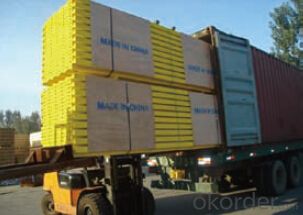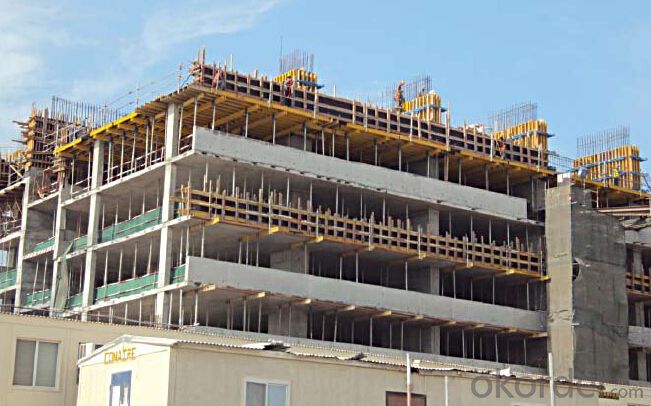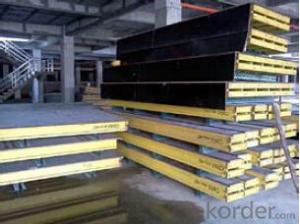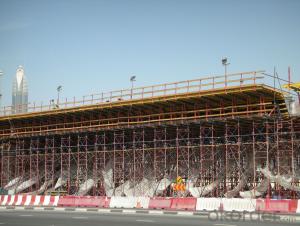Timber Beam Formwork and H20 for Formwork and scaffolding system
- Loading Port:
- Tianjin
- Payment Terms:
- TT OR LC
- Min Order Qty:
- 50 m²
- Supply Capability:
- 1000 m²/month
OKorder Service Pledge
OKorder Financial Service
You Might Also Like
Characteristics:
◆ Standardized production lines.
Supply capability: 3000m/day, Lmax = 6600mm.
◆ Finger jointing of the flange and web, the strength of timber beam is highly improved.
Max. shearing force failure load:40KN
◆ Well treated to prevent from water penetration or erosion, so the service life maximally
extended.
Normally, CNBM timber beam H20 can be used for 4 to 5 years, the exact using time would
depend on maintenance & storage.
◆ Robust caps at the end of the girders protect against damages.




- Q: What are the considerations when designing steel formwork for columns?
- When designing steel formwork for columns, several considerations need to be taken into account. Firstly, the load-bearing capacity of the formwork needs to be determined based on the weight of the concrete and any additional loads that may be applied. The formwork should also be designed to withstand the pressure exerted by the fresh concrete during pouring and curing. Another important consideration is the size and shape of the column. The formwork needs to be customized to match the dimensions and contours of the column to ensure a precise and accurate mold. Additionally, the formwork should be designed to allow for easy installation and removal, as well as easy access for concrete pouring and finishing. Durability is also a significant factor. The steel formwork must be sturdy and robust enough to withstand the repetitive use and handling during the construction process. It should be able to resist wear and tear, as well as any potential impacts or vibrations that may occur on the construction site. Furthermore, safety considerations are paramount. The formwork should be designed to provide a stable and secure working platform for the workers involved in the installation and pouring of concrete. Adequate precautions must be taken to prevent any potential accidents or collapses. Lastly, cost-effectiveness is an important consideration. The design should aim to minimize material and labor costs while still meeting the required strength and durability standards. Efficient use of materials and ease of assembly and disassembly can contribute to cost savings. Overall, when designing steel formwork for columns, considerations such as load-bearing capacity, column size and shape, durability, safety, and cost-effectiveness are crucial to ensure a successful and efficient construction process.
- Q: How does steel formwork handle different concrete strength requirements?
- Steel formwork proves to be a highly versatile and durable solution, capable of effectively managing a wide range of concrete strength demands. Concrete strength is influenced by its mixture proportions, curing conditions, and the quality of materials employed. By providing a reliable and secure framework for pouring concrete, steel formwork plays a pivotal role in fulfilling these requirements. One notable advantage of steel formwork lies in its ability to withstand the immense pressures and strong vibrations encountered during concrete pouring and compaction. This becomes particularly crucial when dealing with high-strength concrete, as it necessitates greater force application to attain the desired density and durability. Thanks to its structural integrity and rigidity, steel formwork can bear these forces without deformations or failures, consequently ensuring a consistent and uniform distribution of the concrete. Another key benefit of steel formwork is its flexibility in terms of shape and size, allowing for customization to accommodate diverse concrete strength specifications. This versatility facilitates the construction of various structural elements, including columns, beams, walls, and slabs, each with unique strength requirements. Additionally, steel formwork can be effortlessly assembled and disassembled, making it adaptable to different projects and enabling the reuse of formwork components. Moreover, steel formwork imparts a smooth and precise finish to the concrete surface, a crucial factor in achieving desired aesthetics and functionality. This is particularly important for architectural or decorative concrete, where a high-quality finish is imperative. The smooth and flat surface provided by steel formwork ensures even curing of the concrete and minimizes the risk of surface defects. To summarize, steel formwork is well-suited to handle diverse concrete strength requirements due to its robustness, durability, adaptability, and ability to deliver a smooth finish. Its strength and flexibility make it an ideal choice for construction projects demanding varying concrete strengths, guaranteeing the successful execution of diverse structural designs and meeting performance expectations.
- Q: Can steel formwork be used for suspended slabs?
- Yes, steel formwork can be used for suspended slabs. Steel formwork offers high strength and durability, making it suitable for supporting the weight of the concrete and reinforcing bars in suspended slab construction. It provides a stable and secure platform for pouring concrete, ensuring proper alignment and smooth finishing of the slab. Additionally, steel formwork can be easily reassembled and reused, making it a cost-effective option for suspended slab applications.
- Q: Does steel formwork require special equipment for installation?
- Yes, steel formwork does require special equipment for installation. This can include cranes, forklifts, and other heavy machinery to lift and position the steel formwork panels accurately. Additionally, specialized tools like tie rods, clamps, and brackets may be necessary to secure the formwork in place during the concrete pouring process.
- Q: Can steel formwork be used for precast concrete slabs?
- Yes, steel formwork can be used for precast concrete slabs. Steel formwork is a commonly used method for creating the molds or formwork for pouring concrete in precast construction. Steel formwork offers several advantages, including high durability, reusability, and superior strength compared to other types of formwork materials. It provides a rigid and stable structure that can withstand the weight and pressure of the concrete during the casting process. Steel formwork also allows for precise shaping and finishing of the concrete slabs, ensuring a high-quality and consistent end product. It can be easily assembled and disassembled, making it suitable for repetitive use in precast concrete production. Additionally, steel formwork can be designed and customized to meet specific project requirements, including different sizes, shapes, and patterns for the concrete slabs. However, it is important to consider the cost and maintenance of steel formwork, as it can be more expensive compared to other types of formwork materials such as wood or plastic. Regular maintenance and cleaning are necessary to ensure the longevity and efficiency of steel formwork. Overall, steel formwork is a reliable and widely used option for creating molds for precast concrete slabs, offering numerous benefits in terms of strength, durability, and customization options.
- Q: How does steel formwork handle moisture and humidity?
- Steel formwork is highly resistant to moisture and humidity due to its inherent properties and effective protective measures. The steel used in formwork construction is typically treated with anti-corrosion coatings, such as galvanization or epoxy paint, which create a barrier against moisture penetration. These coatings protect the steel from the corrosive effects of water, preventing rust formation and structural degradation. Additionally, steel formwork systems are designed with tight joints and connections to ensure minimal water ingress. This reduces the risk of moisture accumulation within the formwork, which could potentially weaken the structure or affect the quality of the concrete. Furthermore, steel formwork is non-absorbent, meaning it does not absorb water or humidity. This characteristic prevents swelling, warping, or distortion of the formwork due to moisture exposure. It also ensures consistent and accurate dimensions of the formwork, resulting in precise concrete shapes and finishes. In cases where steel formwork is exposed to high levels of moisture or humidity, such as in marine or coastal environments, additional protective measures can be taken. These may include applying specialized coatings or using stainless steel formwork, which offers superior resistance to corrosion and moisture. Overall, steel formwork is well-suited for handling moisture and humidity. Its resistance to corrosion, non-absorbent nature, and ability to maintain structural integrity even in challenging environmental conditions make it a reliable and durable choice for construction projects.
- Q: What are the different types of edge protection used with steel formwork?
- There are several types of edge protection used with steel formwork to ensure safety and prevent accidents on construction sites. Some of the common types include: 1. Edge protection barriers: These are typically made of a sturdy material like steel or aluminum and are installed along the edges of the formwork. They act as a physical barrier to prevent workers from accidentally falling off the edge. Edge protection barriers are often adjustable and can be easily installed and removed as needed. 2. Toe boards: Toe boards are typically made of wood or steel and are installed along the lower edge of the formwork. They provide a barrier to prevent tools, equipment, or debris from falling off the edge. Toe boards also serve as a visual indicator, reminding workers to be cautious near the edge. 3. Handrails: Handrails are horizontal bars that are attached to vertical posts and are installed along the edges of the formwork. They provide a secure handhold for workers, helping them maintain balance and stability, especially when working at heights. Handrails are often required by safety regulations in certain situations. 4. Safety nets: Safety nets are installed below the formwork to catch any falling objects or debris. They are typically made of high-strength mesh material and are designed to absorb the impact of a falling object. Safety nets are useful when there is a risk of objects falling off the edge, such as during concrete pouring or during the removal of formwork. 5. Harnesses and lifelines: In certain high-risk situations, workers may be required to wear harnesses and use lifelines to protect themselves from falling. These systems consist of a harness that is worn by the worker and connected to a lifeline, which is securely anchored to a structure. Harnesses and lifelines provide an additional layer of protection in situations where edge protection alone may not be sufficient. It is important to note that the choice of edge protection will depend on the specific requirements of the project, local regulations, and the level of risk associated with the work being performed. It is crucial for construction companies to assess the site conditions and implement appropriate edge protection measures to ensure the safety of workers.
- Q: How does steel formwork handle formwork stability during concrete pouring?
- Steel formwork provides excellent formwork stability during concrete pouring due to its high strength and rigidity. It can withstand the pressure and weight of the fresh concrete without deformation or collapse, ensuring the desired shape and structure of the concrete elements. Additionally, steel formwork can be easily adjusted and secured in place, allowing for precise alignment and stability during the pouring process.
- Q: What is the lifespan of steel formwork compared to other types of formwork?
- Compared to other types of formwork, the lifespan of steel formwork is generally longer. Steel, known for its high durability, is capable of withstanding heavy loads and extreme weather conditions, making it an ideal material for construction purposes. With proper maintenance and care, steel formwork can endure for several decades. In contrast, wooden and plastic formwork have a shorter lifespan. Wood is vulnerable to rotting, warping, and termite infestation, which significantly reduces its longevity. Plastic formwork, although lightweight and easy to handle, may deteriorate over time due to exposure to UV radiation and general wear and tear. Another advantage of steel formwork is its reusability. Once a concrete structure is finished, the steel formwork can be disassembled and utilized for other construction projects, minimizing the need for new formwork and reducing waste. While the initial investment for steel formwork may be higher compared to other materials, its longer lifespan and reusability make it a cost-effective choice in the long term. Moreover, steel formwork provides exceptional structural stability, ensuring the integrity and quality of the formed concrete structure.
- Q: Can steel formwork be used for structures with high thermal insulation requirements?
- Steel formwork is not typically used for structures with high thermal insulation requirements. This is because steel is a good conductor of heat, meaning it allows heat to easily transfer through it. As a result, using steel formwork in structures that require high thermal insulation would lead to significant heat loss, reducing the overall energy efficiency of the building. To achieve high thermal insulation, materials with good thermal resistance such as insulating concrete forms (ICFs), expanded polystyrene (EPS), or other insulated formwork systems are preferred. These materials have low thermal conductivity and provide a barrier against heat transfer. By using such materials, structures can meet the high thermal insulation requirements and improve energy efficiency. However, it is worth mentioning that steel formwork can still be used in combination with insulation materials to provide structural support and form the shape of the structure. In this case, additional insulation measures, such as applying insulation layers or using insulation inserts, would be necessary to enhance the thermal performance of the structure. Overall, while steel formwork can be suitable for many construction projects, it is not the ideal choice for structures with high thermal insulation requirements.
Send your message to us
Timber Beam Formwork and H20 for Formwork and scaffolding system
- Loading Port:
- Tianjin
- Payment Terms:
- TT OR LC
- Min Order Qty:
- 50 m²
- Supply Capability:
- 1000 m²/month
OKorder Service Pledge
OKorder Financial Service
Similar products
Hot products
Hot Searches
Related keywords




















